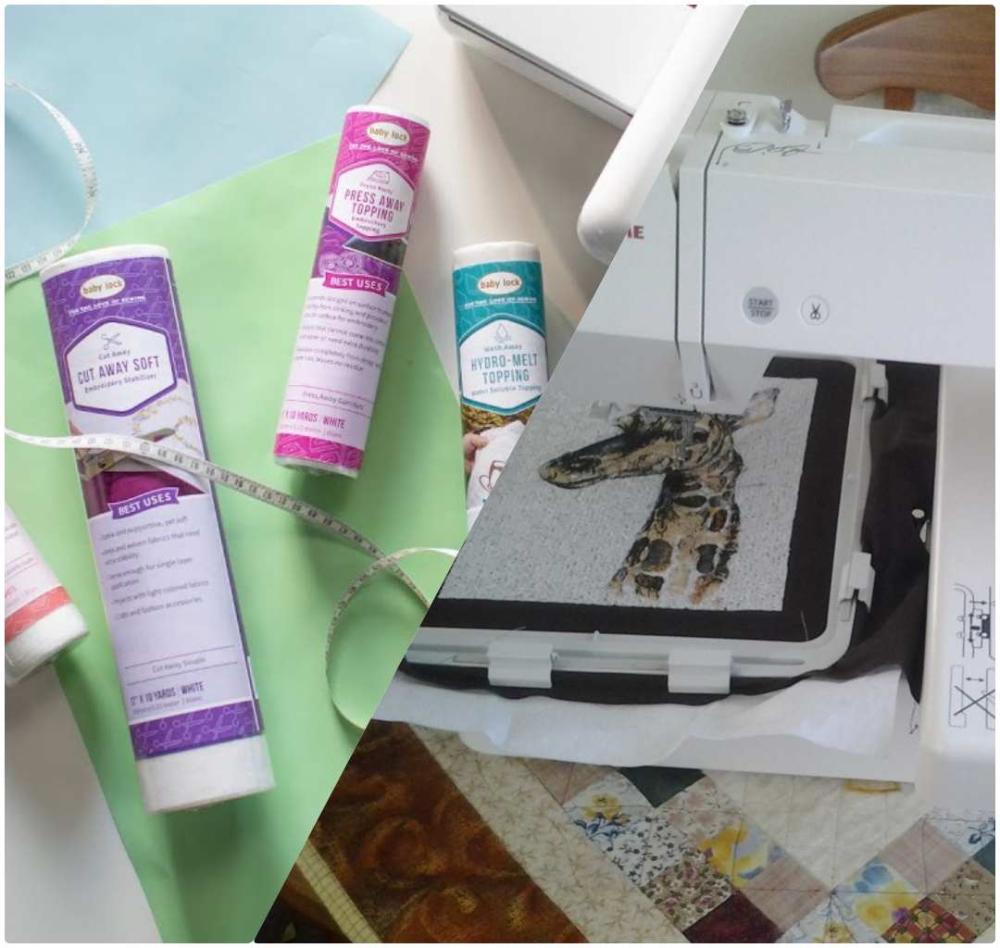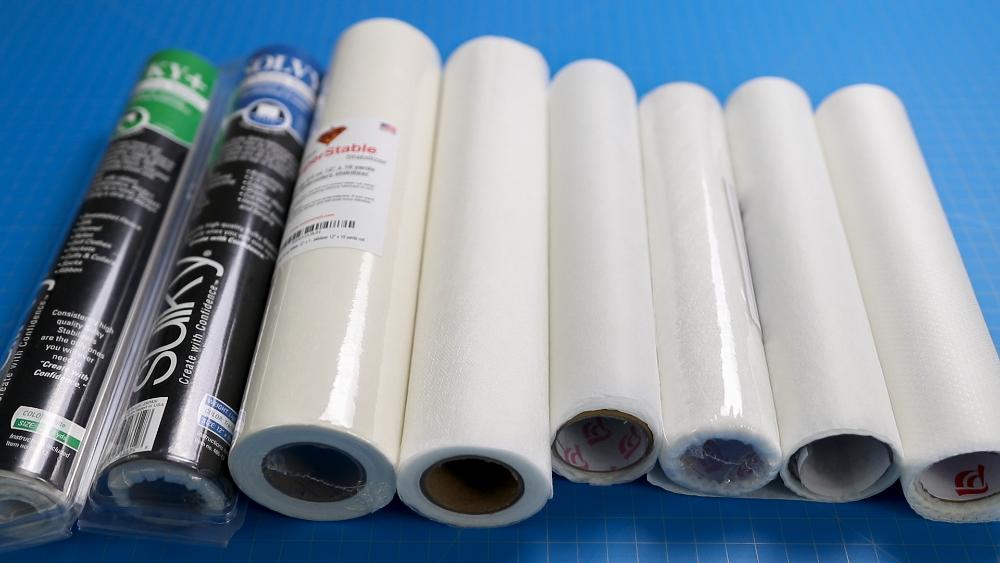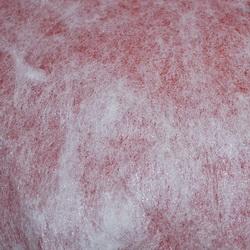Search the Community
Showing results for tags 'cut away'.
-
Are you new to the world of machine embroidery? One of the first terms you'll hear is "backing" or "stabilizer." Embroidery backings are essential for creating stability when machine embroidering on any fabric, particularly stretchy knits and polyester performance shirts. When it comes to starting an embroidery project, choosing the right stabilizer is one of the most important decisions you'll make. Proper stabilization is the foundation of excellent embroidery, and choosing the wrong stabilizer can lead to poor results. In this article, we'll take a closer look at embroidery stabilizers and help you make informed decisions when starting your next embroidery project. Fashion teddy bear embroidery design What is an Embroidery Stabilizer? If you've ever worn an embroidered shirt, you've probably seen embroidery backing before. It's the fabric that sits behind the stitches, providing support during the embroidery process. Embroidery backings are typically wet-laid nonwovens, which means they're made up of random fibers held together by a binder. The non-directional nature of nonwoven backings makes them strong and stable for use as embroidery stabilizers. However, it's important to use nonwovens specifically designed for machine embroidery. Some people advocate using things like coffee filters, newspaper, or paper towels as backing, but these products can break up during embroidery, causing excessive lint in your bobbin cases and machine parts. What are the Different Types of Embroidery Backing? There are three major types of embroidery stabilizers: Cut Away, Tear Away, and Water Soluble. Most backings come in different weights, usually advertised as ounces per square yard. The heavier the backing, the more stability it usually provides. A good backing supplier will sell many different weights, types, and sizes of stabilizer in both pre-cut sheets and on rolls. Mosaic horse embroidery design Cut Away Backings Cut Away backings provide the most stability and remain on the garment, keeping it stable after being embroidered. With a Cut Away backing, after you finish embroidering, you cut away the excess backing close to the design, and the rest stays on the fabric. For beginner embroiderers, we always recommend using a cutaway with most unstable fabrics and anything you're going to wear. Cut Aways are inherently more stable and will be more forgiving with some of the mistakes you make when you're new to machine embroidery. They're a great choice for stretchy knits and polyester performance shirts because they prevent embroidered designs from stretching with repeat wearing and washing. Tear Away Backings Tear Away backings are removed, or torn away, from the fabric after embroidery. They're generally less stable than cutaways and are used for light support, on less stretchy fabrics, and items where the back may be visible, like towels and linens. With Tear Away stabilizers, you just tear away the backing when you finish embroidering. For large commercial shops, this can speed up the entire embroidery process when encountering large jobs. Tear Away can also be used in conjunction with a Cut Away to provide additional support during embroidery without adding additional bulk to the finished garment. Water Soluble Stabilizers Water Soluble Stabilizers dissolve when immersed in water. There are two types of Water Soluble Stabilizers (WSS) – a film type called Badgemaster and a nonwoven fabric type called Vilene. Both work the same way, and it's personal preference which one you use. WSS should mostly be used for free-standing lace (FSL) type applications, where you need the backing to 100% disappear. Remember, this backing dissolves in water, so if you use it as a regular stabilizer, you'll lose stabilization under the
-
Embroidery is an art form that requires patience, skill, and the right materials to achieve beautiful results. One crucial component that every experienced embroiderer knows is stabilizer. The use of stabilizer helps to support your fabric and thread, ensuring that your design is aligned, and your fabric doesn't distort or pucker. In this article, we'll answer some of the most common questions about stabilizers and provide you with a machine embroidery stabilizer guide to help you get professional results. What Brand Of Stabilizer Should You Use? When it comes to choosing the right brand of stabilizer, we recommend buying from a reliable embroidery source online or supporting your local dealer and using the brand they sell. In most cases, we shop for stabilizers based on price point rather than who they're made by because most stabilizers are created by a handful of main manufacturers and then white-labeled by different embroidery brands. However, avoid purchasing stabilizers from "big box stores" such as Walmart or Michaels. While you may save a few bucks, the quality of the stabilizer is usually subpar, and you won't get a consistent stitch. Why Is Stabilizer So Important? Stabilizer is the foundation of your embroidery, and it's essential to use the proper stabilizer for the best results. Without it, the registration of the design may be off, and you might experience puckering or distortion of the fabric. Think of stabilizer as the glue that holds everything together. Your choice of stabilizer can "make or break" your stitch out, and a poorly stabilized fabric can cause your design to look unprofessional. The Main Types of Embroidery Stabilizers and When to Use Them There are three types of embroidery stabilizers: tear away, wash away, and cut away. Each of these stabilizers is also available as fusible or tacky. The type of stabilizer you should use depends on the fabric you're using. Use Cut Away stabilizer if the fabric has any stretch – t-shirts, sweatshirts, knits, etc. Use Tear Away stabilizer if the fabric is stable woven. Use Wash Away if using a sheer fabric or freestanding lace design such as our Vintage Lace, 3D Flowers, 3D Butterflies, or 3D Leaves, etc. In addition to the three types of stabilizers, most brands also have specialty products to use in your embroidery designs . These include fabric preps that help stabilize fabrics that unravel, distort, or pucker. They add stitch counts to your fabric, so it's ideal to use with a heavy stitch count design. There are also products that add varying textures. They add a firm shape or a soft foam shape, which help with applique without adding any bulk and cover the stitches so they won't irritate your skin. These products do not replace stabilizer but can be used with tear away or cut away stabilizers. In conclusion, if you're looking to achieve professional results with your embroidery, it's crucial to understand stabilizers and the different types available. Using the right stabilizer for your fabric type will ensure that your designs machine embroidery looks its best, without any puckering or distortion. By following this machine embroidery stabilizer guide, you'll be on your way to creating beautiful, high-quality embroidery that stands out from the rest. And always remember, a well-stabilized fabric is the key to a successful embroidery project.
- 1 comment
-
- 2
-

-

-
- wash away
- embroidery
-
(and 3 more)
Tagged with:
-
Original text by Marina Belova Proper stabilization of the fabric during the embroidery in order to prevent the distortion remains one of the most acute problems. Even in my not so long embroidery career, numerous garments were ruined simply because of disinclination or, more often, inability to use the stabilizers (or interfacing materials). It goes without saying that, unfortunately, I don't always use them even now. The rules of choosing a stabilizer (or interfacing) are very simple and quite logical. It only takes to comprehend them once in order to use a suitable kind of stabilizer in any particular case in future. In my opinion, all stabilizers should be divided into two main categories: Backings Toppings Below I'll only list the types of stabilizers commonly used. Backings Backings are special materials, usually non-woven, which are placed under the fabric. They serve to support and stabilize the fabric when it's being embroidered, prevent creasing, distortion, stretch and pull, both during the embroidery and after washing or dry-cleaning. There are several types of backings: Tear-away Cut-away Adhesive Soluble Fusible Tear-away stabilizers This type of stabilizers is good for most fabrics made of natural fibers and gives only a temporary support. Main recommendations: this type of backing is easily removed and can be successfully used with the items where the wrong side can be seen (towels, plaids, scarfs and so on). It is also widely used with non-transparent fabrics of fair colors, with thick and densely woven fabrics made of natural fibers — like denim. Not recommended for knits. Tear-away stabilizers are usually made of paper. And their thickness may vary. Cut-away stabilizers Cut-away backings are used when it is necessary to hold a highly stretchy fabric in place during the embroidery and stabilize it properly. They are necessary to embroider a design with a lot of stitches, in order to avoid gathering of the fabric, preventing the appear of bulges or concavities even after several washes. A cut-away stabilizer is always thicker than a tear-away one. Usually, this is a non-woven fabric made of long fibers on the basis of polyester or rayon. The distribution of the fibers in the backing is also of huge importance. If the fibers are mainly single-oriented, it stretches in tears in this one direction. Therefore, to stabilize the fabric properly you need to use 2 layers of backing, positioning them perpendicularly. Such backings are of varying density. If the fibers in the non-woven material run in multiple directions, it has an uneven grainy structure with knots here and there. This unevenness can make the fabric less stable. But this kind of material is good for the embroidery nevertheless and is used often because it's cheap. This kind of stabilizer can also be of varying density. Bonding short fibers (polyester, rayon, cellulose) together by solvent treatment, you'll get a non-woven fabric of high quality, which is soft like a tear-away stabilizer, has a smooth surface and does not stretch in any direction. This stabilizer can be of varying density and just 1 layer of it is sufficient. It is considered most optimal for stabilizing because it does not add extra volume to the embroidery and is invisible through the fabric. Recommendations: to add stability to this kind of backing you can spray it with temporary spray adhesive. Among the cut-away stabilizers spunbond stands out — thin, very soft material that resembles a waffle. There are stabilizers produced in the USA that are called Poly Mesh or No Show Mesh. This kind of backing is good because it does not stretch at all, providing support all the time and is not visible through the fabric. It comes in various colors and densities. This kind of stabilizer is good for embroidery on knitwear. Adhesive stabilizers They allow the item to be stuck onto them, thus stabilizing the fabric. There are several types of them: Ordinary stabilizer with glue on one side. The item is stuck onto such backing with an iron. Adhesive paper with glue on one side that is covered with a protective layer. This paper is necessary when embroidering tricky fabrics: velvet, cashmere, leather, which are not recommended for hooping. And also for the items that are hard to hoop: collars, cuffs, small details. The paper is placed in the hoop with the sticky side up, then the protective layer is removed and the item is placed on top. Afterward, you simply tear the paper away from the item. Solvent stabilizers Solvent stabilizers include a water-soluble stabilizer that is very much like fabric and water-soluble film of varying density. They are used for stabilizing the embroidery when it is necessary to remove the backing for good so that it was not at all visible. For example, organza, transparent fabrics, FSL and also cutwork. Read more on using this kind of stabilizer here. Fusible stabilizers They are used when it is necessary to stabilize the fabric, which cannot be made wet, but the backing leftovers need to be removed. They can be successfully used for embroidering FSL, as well as water-soluble film. They are usually removed with a very hot iron (no less than 120°) or with the pressing machine through the ordinary paper. Under no circumstances should steam be used with fusible stabilizers. Toppings Toppings are special materials that are placed on top of the fabric. They are necessary to prevent the stitches from sinking into the pile, loops, fur and other such materials, also in loosely-woven fabrics like knits. Gelatin-based toppings are used most often because they can be easily solved in water. We call them wash-away toppings or water soluble toppings (film). There are two main kinds of water-soluble toppings: thin and thick (dense) ones. The thin film is used practically with everything, and thick ones only with high piles. The other type of toppings are fusible toppings (we call them heat-away, fusible or heat-soluble). They are used in cases when the fabric cannot be washed, and therefore, the water-soluble film cannot be used. They are usually removed with a very hot iron (no less than 120°) or with the pressing machine through the ordinary paper. Under any circumstances don't use steam with fusible stabilizers. Main rules of using the stabilizers The thicker is the fabric, the heavier the backing should be, and vice versa, the thinner the fabric, the less dense the backing. The more stitches are in the design, the denser the design itself should be, and the thicker the backing should be for stabilizing the fabric. When embroidering with metallic threads you should avoid synthetic backings and try to use the ones made of natural fibers (cotton or rayon), like Madeira E-ZEE Cotton Soft. This is necessary because stabilizers made of natural fibers are softer, they create less friction to the thread and needles, so the needle does not overheat and the thread breaks less often. How does one decide which stabilizer to use? Every time you need to answer these questions: the stability of the fabric, the density of the design, stitch lengths, embroidery speed, thread type. All of these parameters determine what your choice will be. Also, you can read my article on matching the fabric with the stabilizer. In the course of time, I singled out the stabilizers that I use the most. I've covered them at length in this blog.
-
I am trying to embroider a company logo on zippered hoodie jackets. Stitch count is 12400 are of stitching is 4" x 3". Mainly satin lettering with a small 1" square in corner. I have tried with a mesh cut away but bobbin thread is pulling up thru design. I have one jacket now that is for getting this set up correctly. I have cleaned machine, oiled, 3 different bobbins. Adjusted tensions on bobbin and needles... tried everything. I have tried mesh on back with solvy on front.. it still looks awful.. Could someone please give me some input. Thank you in advance for any wise wisdom you wish to pass on!






